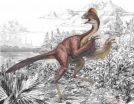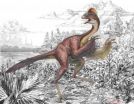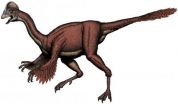(Press-News.org) Fossils found in western North America reveal a new species of large-bodied, feathered oviraptorosaurian theropod dinosaur from the latest Cretaceous Period, according to a paper published in the open-access journal PLOS ONE on March 19, 2014 by Matthew Lamanna from Carnegie Museum of Natural History in Pennsylvania and colleagues.
Known for their beaks, long necks, and relatively short tails, the bird-like oviraptorosaurian group contains dinosaurs with body sizes ranging from a few kilograms to more than one metric ton. The scientists described three well-preserved partial skeletons from the uppermost Cretaceous Hell Creek Formation of North and South Dakota. Collectively, they include bones from most regions of the skeleton, allowing scientists to extensively analyze the body structure and evolutionary relationships of the animal. The authors demonstrate that the fossils pertain to a new genus and species within the oviraptorosaurian group Caenagnathidae, Anzu wyliei. Previously, scientists knew little about Caenagnathidae due to the highly incomplete nature of nearly all described fossils of this group. "Anzu provides our first good look at an entire group of weird dinosaurs that had been shrouded in mystery for nearly a century," explains Dr. Lamanna.
Anzu wyliei is among the largest known oviraptorosaurs, with an approximate body length of 3.5 m, a height at the hip of 1.5 m, and a body mass of about 200-300 kg. The skull of Anzu is deep and narrow, and is crowned by a tall, cassowary-like crest. The vertebrae indicate the dinosaur had a long neck and a short, thick tail. The shape of the jaw in particular places the dinosaur within the caenagnathid group, with its closest relative being the smaller, geologically older species Caenagnathus collinsi. The jaw shape indicates Anzu was capable of feeding on a variety of food items, including vegetation, small animals, and possibly eggs. Studies of the rocks in which the fossils were found indicate that these dinosaurs may have favored humid floodplain habitats over drier environments.
INFORMATION:
Citation: Lamanna MC, Sues H-D, Schachner ER, Lyson TR (2014) A New Large-Bodied Oviraptorosaurian Theropod Dinosaur from the Latest Cretaceous of Western North America. PLoS ONE 9(3): e92022. doi:10.1371/journal.pone.0092022
Financial Disclosure: Funding was provided by the Carnegie Museum of Natural History, an American Association of Anatomists Postdoctoral Fellowship, and an American Philosophical Society Franklin Research Grant to E.R.S., and a National Museum of Natural History Peter Buck Postdoctoral Fellowship to T.R.L. The funders had no role in study design, data collection and analysis, decision to publish, or preparation of the manuscript.
Competing Interest Statement: The authors have declared that no competing interests exist.
PLEASE LINK TO THE SCIENTIFIC ARTICLE IN ONLINE VERSIONS OF YOUR REPORT (URL goes live after the embargo ends):http://dx.plos.org/10.1371/journal.pone.0092022
Large feathered dinosaur species discovered in North America
New dinosaur had crested skull, long neck, large claws
2014-03-19
ELSE PRESS RELEASES FROM THIS DATE:
Fossilized bighorn sheep poop reveals early Holocene population
2014-03-19
Genetic analysis of ancient poop found off the coast of Mexico suggests bighorn sheep may be native to the island, according to a paper published in the open-access journal PLOS ONE on March 19, 2014 by Benjamin Wilder from University of California Riverside and colleagues.
Bighorn sheep were not thought to inhabit Tiburón Island, the largest island in the Gulf of California and Mexico, prior to their introduction in 1975. Scientists discovered fossilized dung in the mountains of Tiburón Island that challenges that assumption. Scientists compared the pellet-shaped poop ...
Bighorn sheep went extinct on desert island in Gulf of California, study finds
2014-03-19
RIVERSIDE, Calif. — Using ancient DNA analysis and other techniques, a research team led by conservation biologists at the University of California, Riverside has determined that bighorn sheep, so named for their massive spiral horns, became extinct on Tiburón Island, a large and mostly uninhabited island just off Sonora, Mexico, in the Gulf of California, sometime in the last millennium — specifically between the 6th and 19th centuries.
The result, published March 19 in PLOS ONE, is a surprise because conventional wisdom among wildlife biologists and the indigenous Seri ...
A 'chicken from hell' dinosaur
2014-03-19
SALT LAKE CITY, March 19, 2014 – Scientists from Carnegie and Smithsonian museums and the University of Utah today unveiled the discovery, naming and description of a sharp-clawed, 500-pound, bird-like dinosaur that roamed the Dakotas with T. rex 66 million years ago and looked like an 11 ½-foot-long "chicken from hell."
"It was a giant raptor, but with a chicken-like head and presumably feathers. The animal stood about 10 feet tall, so it would be scary as well as absurd to encounter," says University of Utah biology postdoctoral fellow Emma Schachner, a co-author of ...
Smithsonian collaborates with paleontologist team to reveal new large, feathered dinosaur
2014-03-19
A team of scientists from the Smithsonian's National Museum of Natural History, the Carnegie Museum of Natural History and the University of Utah has described an unusual bird-like dinosaur previously unknown to science, resembling a cross between a modern emu and a reptile. The new species, Anzu wyliei, lived 68 to 66 million years ago and was identified from three partial skeletons collected from the Upper Cretaceous Hell Creek Formation in North and South Dakota. The species belongs to Oviraptorosauria, a group of dinosaurs mostly known from fossils found in Central ...
Paleontologists announce discovery of Anzu wyliei
2014-03-19
Pittsburgh, Pennsylvania…A team of researchers has announced the discovery of a bizarre, bird-like dinosaur, named Anzu wyliei, that provides paleontologists with their first good look at a dinosaur group that has been shrouded in mystery for almost a century. Anzu was described from three specimens that collectively preserve almost the entire skeleton, giving scientists a remarkable opportunity to study the anatomy and evolutionary relationships of Caenagnathidae (pronounced SEE-nuh-NAY-thih-DAY)—the long-mysterious group of theropod dinosaurs to which Anzu belongs. The ...
High-frequency breathing support for premature babies could lead to better lung function
2014-03-19
A new study led by researchers at King's College London has found that premature babies supported immediately after birth by high-frequency oscillation - a type of breathing support - had better lung function as adolescents than those who received conventional ventilation. The children ventilated with the high frequency method also showed higher academic achievement in three of eight school subjects.
The findings of the research, funded by the National Institute for Health Research (NIHR) Health Technology Assessment (HTA) Programme and the NIHR Biomedical Research Centre ...
Studies advance potential use Of MRI magnetic fields to treat balance disorders
2014-03-19
Expanding on earlier research, Johns Hopkins researchers report that people with balance disorders or dizziness traceable to an inner-ear disturbance show distinctive abnormal eye movements when the affected ear is exposed to the strong pull of an MRI's magnetic field.
The researchers first reported in 2011 in the journal Current Biology that an MRI's magnetic field pushes on the inner ear fluid responsible for maintaining balance, causing subjects undergoing MRI scans to have jerky eye movements and dizziness.
Two new studies now suggest that these strong magnets could ...
New guidelines deem 13 million more Americans eligible for statins
2014-03-19
DURHAM, N.C. – New guidelines for using statins to treat high cholesterol and prevent cardiovascular disease are projected to result in 12.8 million more U.S. adults taking the drugs, according to a research team led by Duke Medicine scientists.
The findings for the first time quantify the impact of the American Heart Association's new guidelines, which were issued in November and generated both controversy and speculation about who should be given a prescription for statins.
In an analysis of health data published online March 19, 2014, in the New England Journal ...
Tracking endangered leatherback sea turtles by satellite, key habitats identified
2014-03-19
AMHERST, Mass. ¬– A first-of-its-kind satellite tagging study of migrating New England leatherback turtles in the North Atlantic offers a greatly improved understanding of their seasonal high-use habitats, diving activity and response to key ocean and environmental features in relation to their search behavior. Leatherbacks are considered endangered species in all the world's oceans.
The study, part of doctoral research by Kara Dodge supervised by her advisor, Molly Lutcavage of the University of Massachusetts Amherst's Large Pelagics Research Center (LPRC) in Gloucester, ...
North Shore-LIJ Cancer Institute doctors' editorial published
2014-03-19
LAKE SUCCESS, NY – Two North Shore-LIJ Cancer Institute doctors, world-renowned for their research in chronic lymphocytic leukemia (CLL), weigh in on a German study of a new drug therapy for CLL in the March 20 edition of the New England Journal of Medicine, the North Shore-LIJ Health System announced today.
CLL is one of the most common forms of blood cancers, usually affecting those later in life. In an editorial written by Kanti Rai, MD, chief of CLL Research and Treatment Program for the health system, and Jacqueline Barrientos, MD, a research hematologist on staff ...
LAST 30 PRESS RELEASES:
Making lighter work of calculating fluid and heat flow
Normalizing blood sugar can halve heart attack risk
Lowering blood sugar cuts heart attack risk in people with prediabetes
Study links genetic variants to risk of blinding eye disease in premature infants
Non-opioid ‘pain sponge’ therapy halts cartilage degeneration and relieves chronic pain
AI can pick up cultural values by mimicking how kids learn
China’s ecological redlines offer fast track to 30 x 30 global conservation goal
Invisible indoor threats: emerging household contaminants and their growing risks to human health
Adding antibody treatment to chemo boosts outcomes for children with rare cancer
Germline pathogenic variants among women without a history of breast cancer
Tanning beds triple melanoma risk, potentially causing broad DNA damage
Unique bond identified as key to viral infection speed
Indoor tanning makes youthful skin much older on a genetic level
Mouse model sheds new light on the causes and potential solutions to human GI problems linked to muscular dystrophy
The Journal of Nuclear Medicine ahead-of-print tip sheet: December 12, 2025
Smarter tools for peering into the microscopic world
Applications open for funding to conduct research in the Kinsey Institute archives
Global measure underestimates the severity of food insecurity
Child survivors of critical illness are missing out on timely follow up care
Risk-based vs annual breast cancer screening / the WISDOM randomized clinical trial
University of Toronto launches Electric Vehicle Innovation Ontario to accelerate advanced EV technologies and build Canada’s innovation advantage
Early relapse predicts poor outcomes in aggressive blood cancer
American College of Lifestyle Medicine applauds two CMS models aligned with lifestyle medicine practice and reimbursement
Clinical trial finds cannabis use not a barrier to quitting nicotine vaping
Supplemental nutrition assistance program policies and food insecurity
Switching immune cells to “night mode” could limit damage after a heart attack, study suggests
URI-based Global RIghts Project report spotlights continued troubling trends in worldwide inhumane treatment
Neutrophils are less aggressive at night, explaining why nighttime heart attacks cause less damage than daytime events
Menopausal hormone therapy may not pose breast cancer risk for women with BRCA mutations
Mobile health tool may improve quality of life for adolescent and young adult breast cancer survivors
[Press-News.org] Large feathered dinosaur species discovered in North AmericaNew dinosaur had crested skull, long neck, large claws





